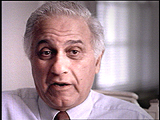

So after my last escape and hiding out, I was sent these papers with a letter of recommendation to join up with a group in the Rhone Valley, in a little town called Saint-Vallier, south of Lyon, which at the time was a hotbed of Gestapo activity under the aegis of Klaus Barbie. I joined with that group in November of 1943, not really knowing what that group was. To me it was a place where I'm going to go to hide out with other young people who had run away, with other not just young people, men who had run away--it had nothing to do with children or women--but when I got there, I knew after a few hours what it was. Speaking to people, who they were, where they came from, and I realized, I had just been sent to a place where we will do, uh, illegal underground activities. What happened in that particular area, or in this particular camp, was mainly instructions--how to circulate with our papers without being detected; what to say if we were in a place like a restaurant, and an inspection team, uh, came in, uh, a patrol came in; how to act, act natural, and to never speak your, let on that you speak, uh, the language other than what you are, a Frenchman; don't fall into traps. And they were teaching some of us young people certain, uh, trades there, too, so that the time should not go entirely, with the knowledge that within some time, we will be sent to certain areas where they can use our services.
So after my last escape and hiding out, I was sent these papers with a letter of recommendation to join up with a group in the Rhone Valley, in a little town called Saint-Vallier, south of Lyon, which at the time was a hotbed of Gestapo activity under the aegis of Klaus Barbie. I joined with that group in November of 1943, not really knowing what that group was. To me it was a place where I'm going to go to hide out with other young people who had run away, with other not just young people, men who had run away--it had nothing to do with children or women--but when I got there, I knew after a few hours what it was. Speaking to people, who they were, where they came from, and I realized, I had just been sent to a place where we will do, uh, illegal underground activities. What happened in that particular area, or in this particular camp, was mainly instructions--how to circulate with our papers without being detected; what to say if we were in a place like a restaurant, and an inspection team, uh, came in, uh, a patrol came in; how to act, act natural, and to never speak your, let on that you speak, uh, the language other than what you are, a Frenchman; don't fall into traps. And they were teaching some of us young people certain, uh, trades there, too, so that the time should not go entirely, with the knowledge that within some time, we will be sent to certain areas where they can use our services.
Describes resistance training and activities in a French underground group he joined in 1943
[Interview: 1992]
After the Germans annexed Austria in 1938, Leo attempted to flee. He eventually reached Belgium. In 1940 he was deported to the St.-Cyprien camp in France but escaped. In 1942 Leo was smuggled into Switzerland but was arrested and sent back to France, this time to the Rivesaltes and Drancy camps. He and a friend escaped from a train deporting them to Auschwitz in Poland. Leo joined the French underground in 1943. He arrived in the United States in 1947.
— US Holocaust Memorial Museum - Collections
Jewish Resistance (Abridged Article) »